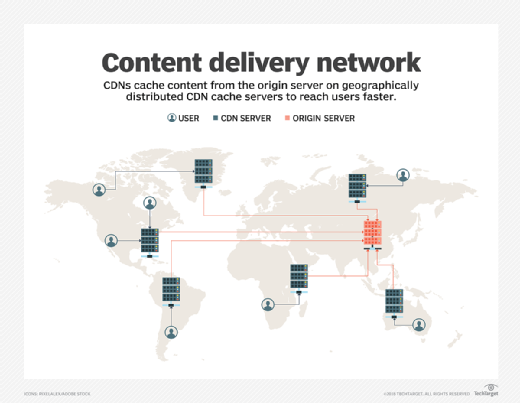
Getty Images/iStockphoto
CDN vs. cloud computing: What's the difference?
Content delivery networks and cloud computing architectures may appear to serve the same function. But each has a specific role to play when distributing content.
At first glance, a content delivery network, or CDN, and a traditional cloud infrastructure may look similar. Yet, the purpose and goals of these technologies are quite different. Let's look at what a CDN is and why it's often compared to cloud technology, as well as pit a CDN vs. cloud computing.
What is a CDN?
The world is a big place. While the internet delivers digital content and services globally, the time it takes for a user to access those resources can vary widely. It all depends on where the servers storing the needed information are located -- and how far away they might be from the user making the request.
One solution to this problem is to move content closer to the user. This strategy helps reduce network latency since data doesn't have to travel as far over what could be vast geographic distances.
CDNs were developed to deliver web data in a reasonable amount of time for all users, regardless of geographic location. This occurs by duplicating digital content and placing that content on delivery servers housed at strategic physical locations across a large area. These distribution locations, dubbed points of presence (POPs), are interconnected and managed across a network so that content can be rapidly updated on the fly.
When users attempt to access content within a CDN, the platform directs them to the nearest POP containing the requested information. This framework enables users to access content quickly and reduces network congestion during times of high demand.
Examples of content distributed via CDNs include advertisements and associated imagery, streaming video, e-commerce, financial trading and data from other interactive- and video-intensive websites that cater to users around the world.

CDN vs. cloud: Similarities and differences
Cloud computing and CDNs are similar because they each serve content from geographically distributed servers. But this is where they vary: A CDN delivers content as quickly as possible, while cloud computing is based on flexibility, scalability and on-demand delivery of applications and data. Data access is a concern for cloud computing, but it's a much lower priority for these providers. And it often relies on different techniques to ensure remote users get the information they need.
In many regards, a CDN more closely resembles today's edge computing architecture rather than a traditional cloud computing framework. Like CDNs, edge computing is built on offering users, wherever they may be, low-latency access to resources.







